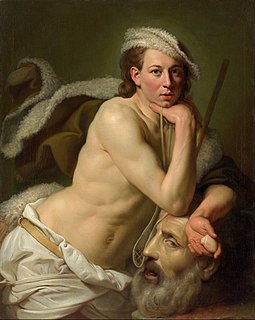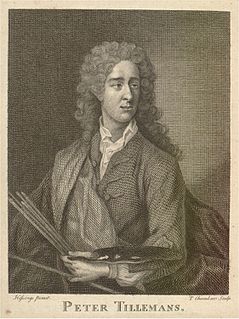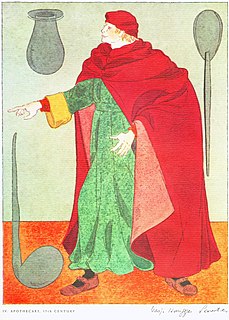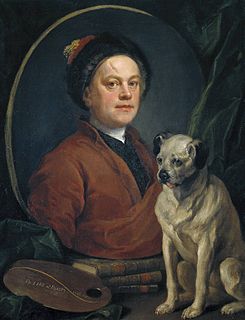
Thomas Gainsborough FRSA was an English portrait and landscape painter, draughtsman, and printmaker. Along with his bitter rival Sir Joshua Reynolds, he is considered one of the most important British portrait artists of the second half of the 18th century. He painted quickly, and the works of his maturity are characterised by a light palette and easy strokes. Despite being a prolific portrait painter, Gainsborough gained greater satisfaction from his landscapes. He is credited as the originator of the 18th-century British landscape school. Gainsborough was a founding member of the Royal Academy.

Lucian Michael Freud, OM was a British painter and draftsman, specializing in figurative art, and is known as one of the foremost 20th-century portraitists. He was born in Berlin, the son of Jewish architect Ernst L. Freud and the grandson of Sigmund Freud. His family moved to Britain in 1933 to escape the rise of Nazism. From 1942-43 he attended Goldsmiths College, London. He enlisted in the Merchant Navy during the Second World War.

The National Portrait Gallery (NPG) is an art gallery in London housing a collection of portraits of historically important and famous British people. It was the first portrait gallery in the world when it opened in 1856. The gallery moved in 1896 to its current site at St Martin's Place, off Trafalgar Square, and adjoining the National Gallery. It has been expanded twice since then. The National Portrait Gallery also has regional outposts at Beningbrough Hall in Yorkshire and Montacute House in Somerset. It is unconnected to the Scottish National Portrait Gallery in Edinburgh, with which its remit overlaps. The gallery is a non-departmental public body sponsored by the Department for Culture, Media and Sport.

English art is the body of visual arts made in England. England has Europe's earliest and northernmost ice-age cave art. Prehistoric art in England largely corresponds with art made elsewhere in contemporary Britain, but early medieval Anglo-Saxon art saw the development of a distinctly English style, and English art continued thereafter to have a distinct character. English art made after the formation in 1707 of the Kingdom of Great Britain may be regarded in most respects simultaneously as art of the United Kingdom.

Sir William Beechey was a leading English portraitist of the golden age of British painting.

Sir William Rothenstein was an English painter, printmaker, draughtsman, lecturer, and writer on art. Emerging during the early 1890s, Rothenstein continued to make art right up until his death in the mid-1940s. Though he covered many subjects – ranging from landscapes in France to representations of Jewish synagogues in London – he is perhaps best known for his work as a war artist in both world wars, his portraits, and his popular memoirs, written in the 1930s. More than two hundred of Rothenstein's portraits of famous people can be found in the National Portrait Gallery collection. The Tate Gallery also holds a large collection of his paintings, prints and drawings. Rothenstein served as Principal at the Royal College of Art from 1920 to 1935. He was knighted in 1931 for his services to art. In March 2015 'From Bradford to Benares: the Art of Sir William Rothenstein', the first major exhibition of Rothenstein's work for over forty years, opened at Bradford's Cartwright Hall Gallery, touring to the Ben Uri in London later that year.

Johan Joseph Zoffany, RA was a German neoclassical painter, active mainly in England, Italy and India. His works appear in many prominent British collections such as the National Gallery, London, the Tate Gallery and in the Royal Collection, as well as institutions in Europe, India, the United States and Australia. His name is sometimes spelled Zoffani or Zauffelij.

John Trevor Hayes was a British art historian and museum director. He was an authority on the paintings of Thomas Gainsborough.

George Gower (c.1540–1596) was an English portrait painter who became Serjeant Painter to Queen Elizabeth I in 1581.
William Tate was an English portrait painter who was a student of Joseph Wright of Derby.

Peter Tillemans was a Flemish painter, best known for his works on sporting and topographical subjects. Alongside John Wootton and James Seymour, he was one of the founders of the English school of sporting painting.
Joseph van Aken was a Flemish artist, a portrait, genre and drapery painter who spent most of his career in England. He was noted for his skill in painting fabrics, and was employed as a costume painter by many leading artists.

Heads of Six of Hogarth's Servants is an oil-on-canvas painting by William Hogarth from c. 1750-5. Measuring 63 centimetres (25 in) high and 75.5 centimetres (29.7 in) wide, it depicts the heads of six of his domestic servants. It is held by in the Tate Gallery in London.

Benjamin Smith (1754–1833) was a British engraver, printseller and publisher, active from 1786 to 1833. He was born c. 1754 in London. He worked mainly in dot or stipple engraving, producing portraits, illustrations, and allegorical and biblical subjects after prominent artists of the day.

The Graham Children is an oil painting completed by William Hogarth in 1742. It is a group portrait depicting the four children of Daniel Graham, apothecary to King George II. The youngest child had died by the time the painting was completed.
Judith Emilie Egerton was an Australian-born British art historian and curator. She specialised in eighteenth-century British art and, particularly, the work of George Stubbs.

Trump was a pug owned by English painter William Hogarth. The artist included the dog in several works, including his self-portrait Painter and his Pug, held by the Tate Gallery. In the words of the Tate's display caption, "Hogarth's pug dog, Trump, serves as an emblem of the artist's own pugnacious character."



















